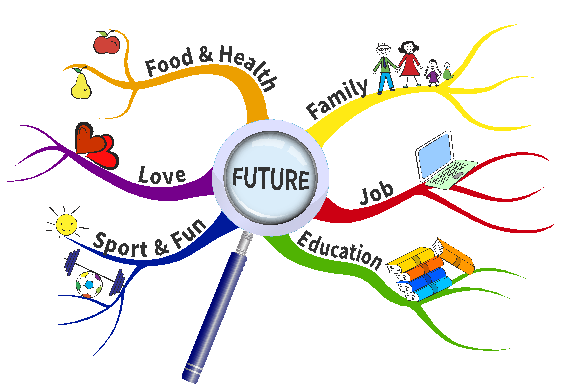1.4: Writing Skills- The Writing Process
- Page ID
- 104376
Your teacher has given you a writing task. What are you going to do? How do you get started?
Brainstorming

Before you write anything, collect some ideas. Let your mind wander, and jot down anything that comes to mind about your topic. You can decide later whether you want to use an idea, or whether you want to discard it.
One way to brainstorm ideas is to try a mind map. A mind map is a simple diagram that allows you to group ideas together and to make connections between them. A mind map looks like this.
Here is a mind map someone has made on the topic of the future.

For this writer, the main ideas are food and health, family, job, education, sport and fun, and love. These are the main branches.
These ideas can be divided into smaller areas. For example, the job category can be further divided into kind of work, place of work, and salary.
Planning
Your mind map will give you a good idea of what you want to write about. At the planning stage, you will decide what to keep and what to discard. You will also decide the order in which you want to present your ideas, and you will make an outline of your writing. Making this outline will save you time later.
You will learn more about planning a good paragraph in Unit 2.
Drafting
After you have made an outline of your paragraph, you are ready to write the first draft. No piece of writing is finished after one draft—you will write at least two. As you write, don’t worry about language use—you will focus on spelling, grammar, and punctuation at a later stage. The goal here is just to get something on paper.
It can be helpful to set a timer as you are drafting. This will force you to write something down, without stopping to check whether everything is correct.
Revising
At this stage, you are still focusing on the content of your writing. Your goal here is to make sure you have a clear piece of writing that contains enough detail about your topic. Check that all the necessary ideas are included, that ideas are presented in the right order, and that there is no unnecessary information in the writing.
A useful checklist to use here is ARMS: Add, Remove, Move, and Substitute.
Add: Bring in more detail, such as examples, to make the writing “come alive” for the reader. Use more adjectives and adverbs.
Remove: Take out information that does not belong in the writing.
Move: Move ideas to a different place in the writing, so that the order of information is more logical.
Substitute: Find a better, more interesting, way of saying something.
It can be useful at this stage to get a classmate to read your writing. See if another reader has ideas for what you can add, take out, and so on.
Editing
Now we come to the final draft. By this stage, your ideas are well expressed and in the right order. Your job now is to tidy up the language. Check for spelling, make sure your punctuation is correct, and make sure there are no grammar mistakes. If you do these things, you should have a clear, correct piece of writing.
In Bring It Together: Writing Task you will write a paragraph on the topic of names. Use what you have learned in this section to help you.

